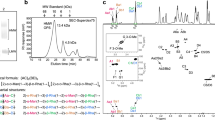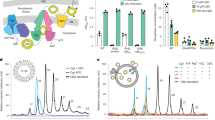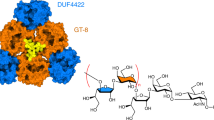Abstract
O-antigens are cell surface polysaccharides of many Gram-negative pathogens that aid in escaping innate immune responses1. A widespread O-antigen biosynthesis mechanism involves the synthesis of the lipid-anchored polymer on the cytosolic face of the inner membrane, followed by transport to the periplasmic side where it is ligated to the lipid A core to complete a lipopolysaccharide molecule2. In this pathway, transport to the periplasm is mediated by an ATP-binding cassette (ABC) transporter, called Wzm–Wzt. Here we present the crystal structure of the Wzm–Wzt homologue from Aquifex aeolicus in an open conformation. The transporter forms a transmembrane channel that is sufficiently wide to accommodate a linear polysaccharide. Its nucleotide-binding domain and a periplasmic extension form ‘gate helices’ at the cytosolic and periplasmic membrane interfaces that probably serve as substrate entry and exit points. Site-directed mutagenesis of the gates impairs in vivo O-antigen secretion in the Escherichia coli prototype. Combined with a closed structure of the isolated nucleotide-binding domains, our structural and functional analyses suggest a processive O-antigen translocation mechanism, which stands in contrast to the classical alternating access mechanism of ABC transporters.
This is a preview of subscription content, access via your institution
Access options
Access Nature and 54 other Nature Portfolio journals
Get Nature+, our best-value online-access subscription
$29.99 / 30 days
cancel any time
Subscribe to this journal
Receive 51 print issues and online access
$199.00 per year
only $3.90 per issue
Buy this article
- Purchase on Springer Link
- Instant access to full article PDF
Prices may be subject to local taxes which are calculated during checkout





Similar content being viewed by others
References
Whitfield, C., Szymanski, C. M. & Aebi, M. in Essentials of Glycobiology 3rd edn (ed. A. Varki ) Ch. 21, 265–282 (Cold Spring Harbor Laboratory Press, 2017)
Raetz, C. R. H. & Whitfield, C. Lipopolysaccharide endotoxins. Annu. Rev. Biochem. 71, 635–700 (2002)
Caboni, M. et al. An O antigen capsule modulates bacterial pathogenesis in Shigella sonnei. PLoS Pathog. 11, e1004749 (2015)
Goebel, E. M., Wolfe, D. N., Elder, K., Stibitz, S. & Harvill, E. T. O antigen protects Bordetella parapertussis from complement. Infect. Immun. 76, 1774–1780 (2008)
Skurnik, M. & Bengoechea, J. A. The biosynthesis and biological role of lipopolysaccharide O-antigens of pathogenic Yersiniae. Carbohydr. Res. 338, 2521–2529 (2003)
Perez, C. et al. Structure and mechanism of an active lipid-linked oligosaccharide flippase. Nature 524, 433–438 (2015)
Liston, S. D., Mann, E. & Whitfield, C. Glycolipid substrates for ABC transporters required for the assembly of bacterial cell-envelope and cell-surface glycoconjugates. Biochim. Biophys. Acta 1862, 1394–1403 (2017)
Cuthbertson, L., Powers, J. & Whitfield, C. The C-terminal domain of the nucleotide-binding domain protein Wzt determines substrate specificity in the ATP-binding cassette transporter for the lipopolysaccharide O-antigens in Escherichia coli serotypes O8 and O9a. J. Biol. Chem. 280, 30310–30319 (2005)
Cuthbertson, L., Kimber, M. S. & Whitfield, C. Substrate binding by a bacterial ABC transporter involved in polysaccharide export. Proc. Natl Acad. Sci. USA 104, 19529–19534 (2007)
Mann, E., Mallette, E., Clarke, B. R., Kimber, M. S. & Whitfield, C. The Klebsiella pneumoniae O12 ATP-binding cassette (ABC) transporter recognizes the terminal residue of its O-antigen polysaccharide substrate. J. Biol. Chem. 291, 9748–9761 (2016)
van der Es, D., Hogendorf, W. F., Overkleeft, H. S., van der Marel, G. A. & Codée, J. D. Teichoic acids: synthesis and applications. Chem. Soc. Rev. 46, 1464–1482 (2017)
Locher, K. P. Mechanistic diversity in ATP-binding cassette (ABC) transporters. Nat. Struct. Mol. Biol. 23, 487–493 (2016)
Lee, J. Y. et al. Crystal structure of the human sterol transporter ABCG5/ABCG8. Nature 533, 561–564 (2016)
Qian, H. et al. Structure of the human lipid exporter ABCA1. Cell 169, 1228–1239 (2017)
Hug, I. & Feldman, M. F. Analogies and homologies in lipopolysaccharide and glycoprotein biosynthesis in bacteria. Glycobiology 21, 138–151 (2011)
Oldham, M. L. & Chen, J. Snapshots of the maltose transporter during ATP hydrolysis. Proc. Natl Acad. Sci. USA 108, 15152–15156 (2011)
Spiwok, V. CH/π interactions in carbohydrate recognition. Molecules 22, http://dx.doi.org/10.3390/molecules22071038 (2017)
Morgan, J. L., Strumillo, J. & Zimmer, J. Crystallographic snapshot of cellulose synthesis and membrane translocation. Nature 493, 181–186 (2013)
Divne, C., Ståhlberg, J., Teeri, T. T. & Jones, T. A. High-resolution crystal structures reveal how a cellulose chain is bound in the 50 Å long tunnel of cellobiohydrolase I from Trichoderma reesei. J. Mol. Biol. 275, 309–325 (1998)
Meyer, J. E. & Schulz, G. E. Energy profile of maltooligosaccharide permeation through maltoporin as derived from the structure and from a statistical analysis of saccharide–protein interactions. Protein Sci. 6, 1084–1091 (1997)
Schirner, K., Stone, L. K. & Walker, S. ABC transporters required for export of wall teichoic acids do not discriminate between different main chain polymers. ACS Chem. Biol. 6, 407–412 (2011)
Kos, V., Cuthbertson, L. & Whitfield, C. The Klebsiella pneumoniae O2a antigen defines a second mechanism for O antigen ATP-binding cassette transporters. J. Biol. Chem. 284, 2947–2956 (2009)
Morgan, J. L. et al. Observing cellulose biosynthesis and membrane translocation in crystallo. Nature 531, 329–334 (2016)
Collaborative Computational Project, Number 4. The CCP4 suite: programs for protein crystallography. Acta Crystallogr. D 50, 760–763 (1994)
Adams, P. D. et al. PHENIX: a comprehensive Python-based system for macromolecular structure solution. Acta Crystallogr. D 66, 213–221 (2010)
Zwart, P. H. et al. Automated structure solution with the PHENIX suite. Methods Mol. Biol. 426, 419–435 (2008)
McCoy, A. J. et al. Phaser crystallographic software. J. Appl. Crystallogr. 40, 658–674 (2007)
Emsley, P. & Cowtan, K. Coot: model-building tools for molecular graphics. Acta Crystallogr. D 60, 2126–2132 (2004)
Painter, J. & Merritt, E. A. Optimal description of a protein structure in terms of multiple groups undergoing TLS motion. Acta Crystallogr. D 62, 439–450 (2006)
Cowtan, K. D. & Zhang, K. Y. Density modification for macromolecular phase improvement. Prog. Biophys. Mol. Biol. 72, 245–270 (1999)
Cowtan, K. Recent developments in classical density modification. Acta Crystallogr. D 66, 470–478 (2010)
Nicholls, R. A., Long, F. & Murshudov, G. N. Low-resolution refinement tools in REFMAC5. Acta Crystallogr. D 68, 404–417 (2012)
DeLano, W. L. The PyMOL Molecular Graphics System (2002)
Ho, B. K. & Gruswitz, F. HOLLOW: generating accurate representations of channel and interior surfaces in molecular structures. BMC Struct. Biol. 8, 49 (2008)
Waterhouse, A. M., Procter, J. B., Martin, D. M., Clamp, M. & Barton, G. J. Jalview version 2—a multiple sequence alignment editor and analysis workbench. Bioinformatics 25, 1189–1191 (2009)
Lin, D. Y., Huang, S. & Chen, J. Crystal structures of a polypeptide processing and secretion transporter. Nature 523, 425–430 (2015)
Hitchcock, P. J. & Brown, T. M. Morphological heterogeneity among Salmonella lipopolysaccharide chemotypes in silver-stained polyacrylamide gels. J. Bacteriol. 154, 269–277 (1983)
Laemmli, U. K. Cleavage of structural proteins during the assembly of the head of bacteriophage T4. Nature 227, 680–685 (1970)
Tsai, C. M. & Frasch, C. E. A sensitive silver stain for detecting lipopolysaccharides in polyacrylamide gels. Anal. Biochem. 119, 115–119 (1982)
Karplus, P. A. & Diederichs, K. Linking crystallographic model and data quality. Science 336, 1030–1033 (2012)
Acknowledgements
We thank J. Morgan and G. Lipkowitz for cloning the full-length Wzm–Wzt transporter, S. Johnson for help with Wzm–WztN purification, C. Caffalette for comments on the manuscript, O. Pornillos for access to SEC-MALS, and the staff at the APS Southeast Regional (SER)- and GM/CA-CAT as well as NSLS-II AMX and FMX beam lines. GM/CA@APS has been funded in whole or in part with federal funds from the National Cancer Institute (ACB-12002) and the National Institute of General Medical Sciences (AGM-12006). The Northeastern Collaborative Access Team beam lines are funded by the National Institute of General Medical Sciences from the National Institutes of Health (NIH) (P41 GM103403). The Pilatus 6M detector on the 24-ID-C beam line is funded by a NIH–ORIP HEI grant (S10 RR029205). Data for this research was also in part collected at the SER Collaborative Access Team beam line at the Advanced Photon Source, Argonne National Laboratory. This research used resources of the Advanced Photon Source, a US Department of Energy (DOE) Office of Science User Facility operated for the DOE Office of Science by Argonne National Laboratory under contract number DE-AC02-06CH11357; and the AMX and FMX beamlines of the National Synchrotron Light Source II, a US DOE Office of Science User Facility operated for the DOE Office of Science by Brookhaven National Laboratory under contract number DE-SC0012704. Y.B. and J.Z. were supported by NIH grant 5R01GM110143. E.M. is a recipient of an Alexander Graham Bell Canada Graduate Scholarship from the Natural Sciences and Engineering Research Council. C.W. was supported by funding from the Canadian Institutes of Health Research. C.W. is a recipient of a Canada Research Chair.
Author information
Authors and Affiliations
Contributions
Y.B. and J.Z. designed all structural and in vitro biochemical experiments, and E.M and C.W. designed the in vivo functional assays. Y.B. and E.M. performed all structural and in vivo functional experiments, respectively. Y.B. and J.Z. wrote, and all authors edited, the manuscript.
Corresponding author
Ethics declarations
Competing interests
The authors declare no competing financial interests.
Additional information
Reviewer Information Nature thanks R. Ford and W. Vollmer and the other anonymous reviewer(s) for their contribution to the peer review of this work.
Publisher's note: Springer Nature remains neutral with regard to jurisdictional claims in published maps and institutional affiliations.
Extended data figures and tables
Extended Data Figure 1 ABC transporter-dependent O-antigen biosynthesis.
In this pathway, O-antigens are completely synthesized on the cytosolic leaflet of the plasma membrane. Undecaprenyl-phosphate (black line and yellow circle) serves as the lipid acceptor and is modified by the addition of an acetylated amino sugar phosphate (frequently N-acetylglucosamine-1-P, white hexagon) as well as two or more additional sugar residues (grey hexagons) to generate a biosynthesis primer. The polymerizing enzyme(s) extend the primer with tens to hundreds of O-antigen repeat units (light blue hexagons). In some species, termination of O-antigen biosynthesis is achieved by modifying the polymer’s non-reducing end (black star). An ABC transporter translocates the UND-PP-linked O-antigen intermediate to the membrane’s periplasmic side, where it forms a substrate for glycosylation of the lipopolysaccharide (LPS) core. Only transporters translocating terminally modified O-antigens contain CBDs that bind the polysaccharide’s modified terminus.
Extended Data Figure 2 Sequence alignment of O-antigen and wall teichoic acid transporters.
a, b, Alignments of the nucleotide-binding (a) and transmembrane domains (b). The conserved tyrosines preceding the cytosolic gate helix of the NBD and the periplasmic gate are highlighted with a red arrow and red box in a and b, respectively. Transmembrane helices and cytosolic and periplasmic gate helices are shown as green and beige cylinders, respectively. Blue sequence labels indicate predicted teichoic acid transporters. All O-antigen transporter NBDs except for K. pneumoniae O2a contain predicted CBDs at their C termini, which are not shown. c, Alignment of the C-terminal region of AaWzt with the corresponding domains from the E. coli O9a (Protein Data Bank accession number 2R5O) and R. terrigena (Protein Data Bank accession number 5HNO) transporters. Sequences were aligned in CLUSTAL Omega and displayed in Jalview coloured by sequence identity.
Extended Data Figure 3 Anomalous difference and experimental electron density maps.
a, Heavy atom positions used for experimental phasing and model building. Five native cysteines in the NBDs as well as an engineered Cys at the C terminus of TM3 (T128C) were modified with ethylmercurithiosalicylic acid, shown as green and red meshes and contoured at 4.5σ and 3σ, respectively. Only the mercury sites shown in green were used for mercury-single anomalous dispersion phasing. The transmembrane domain contains three native Met residues, which were identified upon substitution with seleno-methionine (cyan mesh, contoured at 3σ). Shown are sigma-A-weighted anomalous difference electron densities; AaWzm–WztN is shown as a grey ribbon. b, Unbiased experimental sigma-A-weighted electron density after NCS and cross-crystal averaging and phase extension to 3.85 Å, contoured at 1σ.
Extended Data Figure 4 Overview of type-II ABC exporters and PglK.
a, The structures of the transmembrane domains of A. aeolicus Wzm, Homo sapiens ABCG5 and H. sapiens ABCA1 are shown as cylindrical cartoons. One subunit of the dimers is coloured in rainbow colours from blue to red, N terminus to C terminus. b, Structure of PglK, an ABC transporter translocating UND-PP-linked oligosaccharides across the plasma membrane. PglK probably recognizes the polyprenyl moiety of the substrate via a conserved periplasmic helix (shown in magenta), which is missing in Wzm.
Extended Data Figure 5 Closed conformation of the isolated WztN-NBD.
a, The isolated WztN dimer structure was aligned by secondary matching in Coot with the NBDs of the adenosine 5′-(β,γ-imido)triphosphate-stabilized maltose transporter (Protein Data Bank accession number 3RLF). The WztN dimer is shown in cyan and light blue, and the NBDs of the maltose transporter are shown in light and dark grey. Right: the Walker A (S61) and signature (S143) motifs in the closed WztN dimer structure are separated by approximately 4 Å. b, Comparison of WztN dimer structures. The structure shown in dark blue was obtained from a crystal form containing a WztN dimer in the crystallographic asymmetric unit. The structure shown in grey was obtained from a crystal form with a monomeric WztN per crystallographic asymmetric unit related to the other protomer by two-fold crystallographic symmetry. The signature motifs are coloured cyan and yellow, and the Walker A motifs are coloured magenta and red for the crystallographic monomeric and dimeric WztN structures, respectively.
Extended Data Figure 6 Impact of conserved tyrosine residues of the cytosolic and periplasmic gates on O-antigen translocation.
The indicated point mutations were introduced into the E. coli O9a Wzt–Wzm transporter and O-antigen transport was assayed by silver staining of the whole-cell lysate. Ag, silver-stained SDS–PAGE. Wzt and MBP were detected immunologically to monitor transporter expression and as a loading control, respectively. All results showing a phenotype have been confirmed at least three times as technical replicates. Time, period after inducing Wzt–Wzm expression in minutes.
Extended Data Figure 7 Dimerization of the isolated CBD of Wzt.
Multi-angle static light scattering coupled to size-exclusion chromatography was used to determine the molecular mass of the purified CBD of Wzt (one representative experiment is shown). The molecular mass of a monomeric Wzt-CBD is 20 kDa, including a C-terminal 6×His-tag and linker region. Inset, Coomassie-stained SDS–PAGE of the purified CBD of Wzt.
Extended Data Figure 8 Hydrolytic activity of the Wzm–Wzt ABC transporter.
ATP hydrolytic activity was measured by following the decrease of NADH fluorescence in an enzyme-coupled assay upon excitation at 340 nm and emission at 450 nm in a temperature range from 4 to 65 °C. a, Temperature dependence of the ATPase activity of Wzm–WztN. Shown is the difference in NADH fluorescence between control reactions in the absence of Wzm–WztN and reactions in its presence. b, Hydrolytic activity of full-length Wzm–Wzt in the presence of isolated Wzt-CBD measured at 27 °C. Shown are fluorescence intensity differences (calculated as for Fig. 4b) but not converted to apparent catalytic rates. Dashed line, ATP titration in the presence of only the CBD of Wzt. Hydrolytic activity of Wzm–WztN in the absence of the CBD of Wzt is shown for comparison. c, Comparison of ATPase activities of full-length (green) and truncated (black) Wzm–Wzt. Shown are apparent catalytic rates in detergent-solubilized and liposome-reconstituted states. Data points represent the mean of three independent repeats with s.d. CPS, counts per second.
Extended Data Figure 9 Model of the Wzm–WztN closed conformation.
a, Rigid body alignment of the Wzm–WztN transporter halves with the corresponding NBDs of the closed WztN dimer structure. The closed WztN dimer is shown in grey, and Wzm–WztN is coloured in red and green for Wzm and cyan and blue for WztN. Residues replaced with Cys are shown with spheres at their Cα carbons. Observed disulfide cross-links are indicated with a dashed line. b, Cartoon illustration of the open to closed transition of the transporter. c, Disulfide cross-linking of Wzm protomers. Purified Wzm–WztN transporters harbouring the indicated Cys mutations were oxidized with either copper phenanthroline (Co-Phen) or sodium tetrathionate (STT), blocked with N-ethylmaleimide (NEM), and analysed by western blotting against the N-terminal Wzm Flag-tag. Experiments were repeated three times with similar results. M and D, Wzm monomer and dimer.
Supplementary information
Supplementary Table
This file contains Supplementary Table 1, a list of bacterial strains, plasmids and primers used in the study. (PDF 85 kb)
Rights and permissions
About this article
Cite this article
Bi, Y., Mann, E., Whitfield, C. et al. Architecture of a channel-forming O-antigen polysaccharide ABC transporter. Nature 553, 361–365 (2018). https://doi.org/10.1038/nature25190
Received:
Accepted:
Published:
Issue Date:
DOI: https://doi.org/10.1038/nature25190
This article is cited by
-
Molecular insights into capsular polysaccharide secretion
Nature (2024)
-
A multi-enzyme machine polymerizes the Haemophilus influenzae type b capsule
Nature Chemical Biology (2023)
-
Lipopolysaccharide biosynthesis and traffic in the envelope of the pathogen Brucella abortus
Nature Communications (2023)
-
Evidence for a trap-and-flip mechanism in a proton-dependent lipid transporter
Nature Communications (2022)
-
Molecular interplay of an assembly machinery for nitrous oxide reductase
Nature (2022)
Comments
By submitting a comment you agree to abide by our Terms and Community Guidelines. If you find something abusive or that does not comply with our terms or guidelines please flag it as inappropriate.



